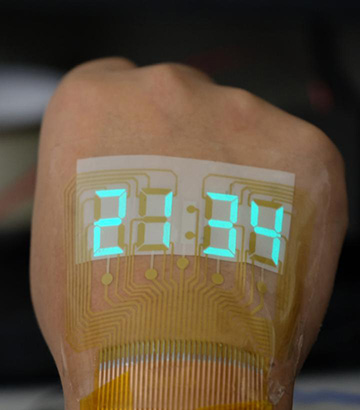
A stretchable light-emitting device becomes an epidermal stopwatch. [Image: Adapted from ACS Materials Letters, doi:10.1021/acsmaterialslett.9b00376 (2019)]
The next time you’re exercising, imagine checking your time and other statistics on a display screen that’s attached to your skin, instead of on a device that you could accidentally drop. Scientists at two Chinese universities have devised this kind of stretchable, low-voltage luminescent screen (ACS Materials Lett., doi: 10.1021/acsmaterialslett.9b00376).
Voltage concerns, safety first
Three types of flexible thin optoelectronics—LEDs with deformable conductors, organic LEDs and alternating-current electroluminescent (ACEL) devices—have been investigated as possible underlying technologies for stretchable, wearable displays. Previous efforts to develop ACEL displays, however, have led to devices with comparatively high operating voltages, which present safety concerns to humans.
The researchers at Nanjing University and Lanzhou University of Technology in China got around the voltage demands by creating high-permittivity ceramic nanoparticles and incorporating them into a flexible elastomer base. The resulting display operates at voltages of 10 to 35 volts.
Encapsulated nanoparticles
Normally, barium titanate (BaTiO3) nanoparticles in the size range the Chinese team used (580 ± 15 nm) are prone to sticking to each other, so the researchers coated them with a water-soluble polymer called PVP and embedded them in a thermoplastic fluoropolymer. The scientists sandwiched the composite material between two electrodes made of stretchable silver nanowires and laminated everything together.
Applying a 17-kHz square-wave electrical signal to the device caused the ceramic–polymer composite layer to glow, up to about 113 cd/m2—considered to be bright enough for viewing in standard indoor lighting conditions. By testing different concentrations of the particles, the team found that a composite consisting of 30% coated-BaTiO3 particles provided the optimal brightness.
To transform the luminescent composite sheet into a stopwatch, the Chinese team sprayed a pattern of silver nanowires onto a glass substrate and transferred it to a flexible elastomer sheet. The four-digit stopwatch display maintained its luminance levels even when deformed under a large tensile strain of roughly 40%. A silicone-based adhesive held the display onto the skin of a human volunteer, and the stopwatch kept on ticking away the seconds even while the volunteer’s hand opened and closed.
